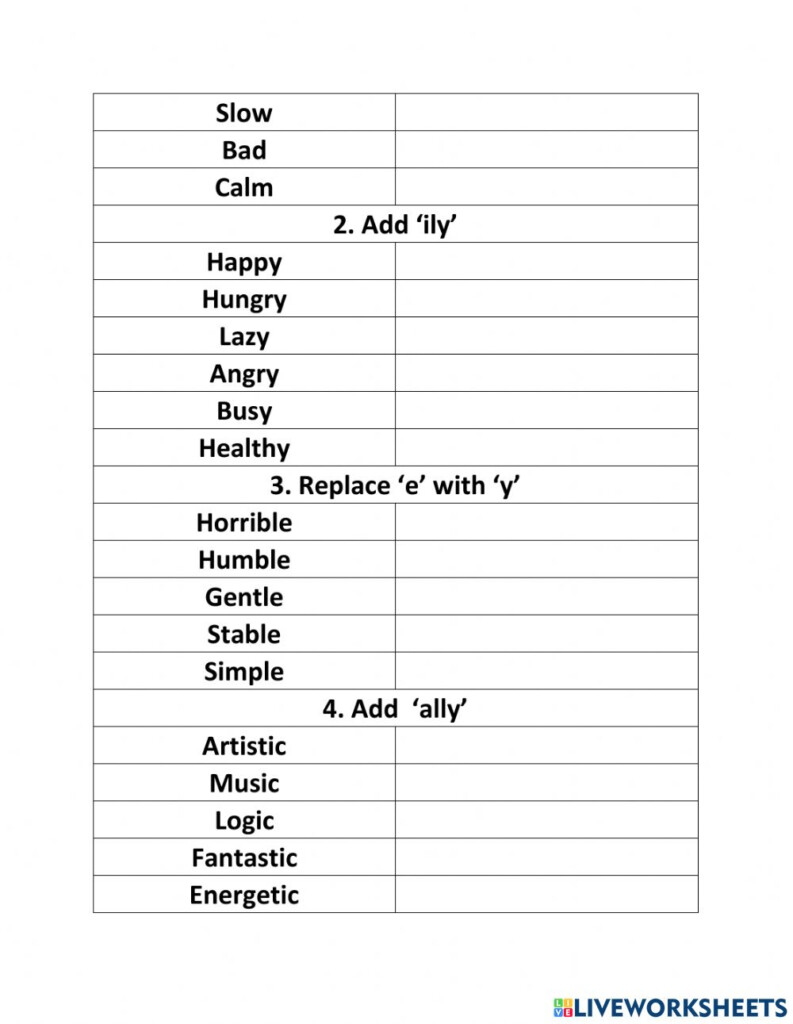Adverbs Year 6 Worksheet – Adverbs are used to describe the meaning of a verb, adjective, or another adjectival. Adverbs are used to identify the time and place it was done. They are typically used prior to the adjective, verb or the adjective they modify.
Here are some examples:
He ran quickly.
She sang beautifully.
They can speak fluent English.
There are a variety of ways to make adjectives. As you can notice, there exist multiple methods to make adjectives. You can create other adverbs through mixing words.
He drives slowly.
He arrived at the right time.
Adverbs are often placed at the beginning or end of sentences. The intention behind the adjective will determine the place it is put.
Adverbs that modify verbs are generally put after them, as you’ll observe. Adverbs that modify adjectives as well as other adjectivals should be put in front of the adjective or modifier they are modifying.
For an example:
He is a slow driver. (incorrect)
He’s a slow car. (correct)
He drives slowly. (correct)
They showed up promptly. (correct)
They were there quite early. (incorrect)
Let’s look at adverbs. These worksheets will allow you to learn to use the adverbs inside sentences. The worksheets are divided into three parts that focus on identifying adverbs, and then forming them.
It is important to read several sentences and highlight the appropriate adverbs. The first section focuses on the identification of Adverbs. The second section is focused on making use of Adverbs. It will show you how to practice using Adverbs using adjectives and verbs. The third part, Making Adverbs will show you how to change adjectives into adverbs.
There’s no need to wait! Take out your pencil and have a look at these adverb worksheets.
Worksheets on Adverbs: Types, and uses
An adverb can be used to describe a verb, adjective or any other words. Adverbs will provide information about when, where, and how the action was carried out. For instance, adverbs are typically placed in conjunction with the verb.
He was slow to move around the space.
A lot of adverbs can be created by adding the suffix -ly to an adjective.
Adjective “Slow”
Adverb: slowly
Adjective: quick
Adverb: quickly
Adjective: hard
Adverb: Hard
Adverbs can be one-word or multiword. For instance, one-word adjectives are the -ly forms.
Slowly, he moved through the room.
Multi-word adjverbs are composed of several words.
He walked slowly around the room.
These are some of the most commonly used multi-word adjectives:
adverb + adverb: quite slowly, extremely quickly
Adverb + adjective Very hot Very cool
Preposition + adverb: Without delay, at the front
There are two types of adjectival terms.
1. Adverbs to describe ways
The adverbs of fashion inform us how something is accomplished. Let’s look at this example:
He slowly moved through each room.
The words slowly reveal how he moved.
Here are a few examples of adverbs that refer to manner.
In a hurry, slowly, and quietly, but loudly and noisily.
2. Adverbs that are related to a specific location
Place adverbs are used to indicate the location of something. Take this example:
He walked around the space.
The sentence makes use of the adverb to show where the man has taken a walk.
There are a handful of examples:
Outside the house, upstairs and down and nothing other than that
There are also adverbs to define frequency and time. Adverbs that talk about frequency and time are, for instance, a way to indicate when something was done.
He moved slowly through each room.
This sentence uses the slow adjectival.
Adverb Worksheets Tips and tricks
Adverbs are the words that modify the meaning of a verb, adjective or another adverb. These worksheets allow you to teach your students the various uses of Adverbs. Here are some useful strategies to make sure you get the most from your worksheets with adverbs.
1. A range of sentence types can be used.
You can use adverbs in many different sentence types. It is recommended to experiment with it and apply it in conjunction with the worksheets you have created. You can use simple sentences as much as complex sentences. This will help your students understand the different uses of adverbs.
2. To highlight, you may use the Adverbs.
When creating worksheets for students, be sure to highlight the adverbs that are within each sentence. It will be easier to find the appropriate adverbs for your students. Highlight all adverbs in one colour or choose a different colour to represent every sentence.
3. Let your students make their own sentences.
Your students should not only complete the blanks on their worksheets, they also need to create sentences using adjectival words. They’ll be at understanding the meaning of adverbs when writing.
FAQs about Adverb Worksheets
1. What are adverbs? How can they be used?
Adverbs are a type of verb or an adjective. Adverbs define when, where or how something was accomplished. They usually end with”-ly”
2. What are the four most used adverbs?
There are four types.
3. How can I utilize Adverbs in my writing?
Adverbs are used to define adjectives and verbs. Adverbs can be a fantastic option to make your writing more engaging.
4. What are some examples of common adjectival terms used?
Common adverbs to use include: slow, fast well, poorly, early, late, hard frequently, and often.





